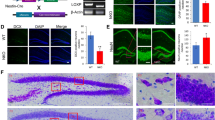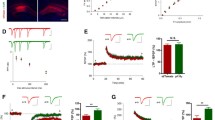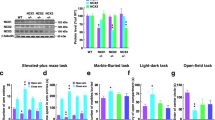Abstract
The Na+/Ca2+ exchanger 1 (NCX1) participates in the maintenance of neuronal Na+ and Ca2+ homeostasis, and it is highly expressed at synapse level of some brain areas involved in learning and memory processes, including the hippocampus, cortex, and amygdala. Furthermore, NCX1 increases Akt1 phosphorylation and enhances glutamate-mediated Ca2+ influx during depolarization in hippocampal and cortical neurons, two processes involved in learning and memory mechanisms. We investigated whether the modulation of NCX1 expression/activity might influence learning and memory processes. To this aim, we used a knock-in mouse overexpressing NCX1 in hippocampal, cortical, and amygdala neurons (ncx1.4over) and a newly synthesized selective NCX1 stimulating compound, named CN-PYB2. Both ncx1.4over and CN-PYB2-treated mice showed an amelioration in spatial learning performance in Barnes maze task, and in context-dependent memory consolidation after trace fear conditioning. On the other hand, these mice showed no improvement in novel object recognition task which is mainly dependent on non-spatial memory and displayed an increase in the active phosphorylated CaMKIIα levels in the hippocampus. Interestingly, both of these mice showed an increased level of context-dependent anxiety.
Altogether, these results demonstrate that neuronal NCX1 participates in spatial-dependent hippocampal learning and memory processes.








Similar content being viewed by others
References
Nicoll DA, Longoni S, Philipson KD (1990) Molecular cloning and functional expression of the cardiac sarcolemmal Na(+)-Ca2+ exchanger. Science 250(4980):562–565
Nicoll DA, Quednau BD, Qui Z, Xia YR, Lusis AJ, Philipson KD (1996) Cloning of a third mammalian Na+–Ca2+ exchanger, NCX3. J Biol Chem 271(40):24914–24921
Li Z, Matsuoka S, Hryshko LV, Nicoll DA, Bersohn MM, Burke EP, Lifton RP, Philipson KD (1994) Cloning of the NCX2 isoform of the plasma membrane Na(+)–Ca2+ exchanger. J Biol Chem 269(26):17434–17439
Papa M, Canitano A, Boscia F, Castaldo P, Sellitti S, Porzig H, Taglialatela M, Annunziato L (2003) Differential expression of the Na+–Ca2+ exchanger transcripts and proteins in rat brain regions. J Comp Neurol 461(1):31–48. https://doi.org/10.1002/cne.10665
Canitano A, Papa M, Boscia F, Castaldo P, Sellitti S, Taglialatela M, Annunziato L (2002) Brain distribution of the Na+/Ca2+ exchanger-encoding genes NCX1, NCX2, and NCX3 and their related proteins in the central nervous system. Ann N Y Acad Sci 976:394–404
Linck B, Qiu Z, He Z, Tong Q, Hilgemann DW, Philipson KD (1998) Functional comparison of the three isoforms of the Na+/Ca2+ exchanger (NCX1, NCX2, NCX3). Am J Phys 274(2 Pt 1):C415–C423
Blaustein MP, Lederer WJ (1999) Sodium/calcium exchange: its physiological implications. Physiol Rev 79(3):763–854
Jeon D, Yang YM, Jeong MJ, Philipson KD, Rhim H, Shin HS (2003) Enhanced learning and memory in mice lacking Na+/Ca2+ exchanger 2. Neuron 38(6):965–976
Molinaro P, Viggiano D, Nistico R, Sirabella R, Secondo A, Boscia F, Pannaccione A, Scorziello A et al (2011) Na+–Ca2+ exchanger (NCX3) knock-out mice display an impairment in hippocampal long-term potentiation and spatial learning and memory. J Neurosci 31(20):7312–7321. https://doi.org/10.1523/JNEUROSCI.6296-10.2011
Secondo A, Esposito A, Petrozziello T, Boscia F, Molinaro P, Tedeschi V, Pannaccione A, Ciccone R et al (2018) Na+/Ca2+ exchanger 1 on nuclear envelope controls PTEN/Akt pathway via nucleoplasmic Ca2+ regulation during neuronal differentiation. Cell Death Discov 4:12. https://doi.org/10.1038/s41420-017-0018-1
Molinaro P, Cataldi M, Cuomo O, Viggiano D, Pignataro G, Sirabella R, Secondo A, Boscia F et al (2013) Genetically modified mice as a strategy to unravel the role played by the Na(+)/Ca(2+) exchanger in brain ischemia and in spatial learning and memory deficits. Adv Exp Med Biol 961:213–222. https://doi.org/10.1007/978-1-4614-4756-6_18
Formisano L, Guida N, Valsecchi V, Pignataro G, Vinciguerra A, Pannaccione A, Secondo A, Boscia F et al (2013) NCX1 is a new rest target gene: role in cerebral ischemia. Neurobiol Dis 50:76–85. https://doi.org/10.1016/j.nbd.2012.10.010
Sirabella R, Secondo A, Pannaccione A, Molinaro P, Formisano L, Guida N, Di Renzo G, Annunziato L et al (2012) ERK1/2, p38, and JNK regulate the expression and the activity of the three isoforms of the Na+/Ca2+ exchanger, NCX1, NCX2, and NCX3, in neuronal PC12 cells. J Neurochem 122(5):911–922. https://doi.org/10.1111/j.1471-4159.2012.07838.x
Formisano L, Saggese M, Secondo A, Sirabella R, Vito P, Valsecchi V, Molinaro P, Di Renzo G et al (2008) The two isoforms of the Na+/Ca2+ exchanger, NCX1 and NCX3, constitute novel additional targets for the prosurvival action of Akt/protein kinase B pathway. Mol Pharmacol 73(3):727–737. https://doi.org/10.1124/mol.107.042549
Secondo A, Molinaro P, Pannaccione A, Esposito A, Cantile M, Lippiello P, Sirabella R, Iwamoto T et al (2011) Nitric oxide stimulates NCX1 and NCX2 but inhibits NCX3 isoform by three distinct molecular determinants. Mol Pharmacol 79(3):558–568. https://doi.org/10.1124/mol.110.069658
Secondo A, Staiano RI, Scorziello A, Sirabella R, Boscia F, Adornetto A, Valsecchi V, Molinaro P et al (2007) BHK cells transfected with NCX3 are more resistant to hypoxia followed by reoxygenation than those transfected with NCX1 and NCX2: possible relationship with mitochondrial membrane potential. Cell Calcium 42(6):521–535. https://doi.org/10.1016/j.ceca.2007.01.006
Annunziato L, Pignataro G, Di Renzo GF (2004) Pharmacology of brain Na+/Ca2+ exchanger: from molecular biology to therapeutic perspectives. Pharmacol Rev 56(4):633–654. https://doi.org/10.1124/pr.56.4.5
Cuomo O, Pignataro G, Sirabella R, Molinaro P, Anzilotti S, Scorziello A, Sisalli MJ, Di Renzo G et al (2016) Sumoylation of LYS590 of NCX3 f-loop by SUMO1 participates in brain neuroprotection induced by ischemic preconditioning. Stroke 47(4):1085–1093. https://doi.org/10.1161/STROKEAHA.115.012514
Molinaro P, Pannaccione A, Sisalli MJ, Secondo A, Cuomo O, Sirabella R, Cantile M, Ciccone R et al (2015) A new cell-penetrating peptide that blocks the autoinhibitory XIP domain of NCX1 and enhances antiporter activity. Mol Ther 23(3):465–476. https://doi.org/10.1038/mt.2014.231
Scorziello A, Savoia C, Sisalli MJ, Adornetto A, Secondo A, Boscia F, Esposito A, Polishchuk EV et al (2013) NCX3 regulates mitochondrial Ca(2+) handling through the AKAP121-anchored signaling complex and prevents hypoxia-induced neuronal death. J Cell Sci 126(Pt 24):5566–5577. https://doi.org/10.1242/jcs.129668
Takamori S, Holt M, Stenius K, Lemke EA, Grønborg M, Riedel D, Urlaub H, Schenck S et al (2006) Molecular anatomy of a trafficking organelle. Cell 127(4):831–846. https://doi.org/10.1016/j.cell.2006.10.030
Juhaszova M, Shimizu H, Borin ML, Yip RK, Santiago EM, Lindenmayer GE, Blaustein MP (1996) Localization of the Na(+)–Ca2+ exchanger in vascular smooth muscle, and in neurons and astrocytes. Ann N Y Acad Sci 779:318–335
Kiedrowski L, Brooker G, Costa E, Wroblewski JT (1994) Glutamate impairs neuronal calcium extrusion while reducing sodium gradient. Neuron 12(2):295–300
Ranciat-McComb NS, Bland KS, Huschenbett J, Ramonda L, Bechtel M, Zaidi A, Michaelis ML (2000) Antisense oligonucleotide suppression of Na(+)/Ca(2+) exchanger activity in primary neurons from rat brain. Neurosci Lett 294(1):13–16
Reuter H, Porzig H (1995) Localization and functional significance of the Na+/Ca2+ exchanger in presynaptic boutons of hippocampal cells in culture. Neuron 15(5):1077–1084
Bouron A, Reuter H (1996) A role of intracellular Na+ in the regulation of synaptic transmission and turnover of the vesicular pool in cultured hippocampal cells. Neuron 17(5):969–978
Sanchez-Armass S, Blaustein MP (1987) Role of sodium–calcium exchange in regulation of intracellular calcium in nerve terminals. Am J Phys 252(6 Pt 1):C595–C603
Molinaro P, Sirabella R, Pignataro G, Petrozziello T, Secondo A, Boscia F, Vinciguerra A, Cuomo O et al (2016) Neuronal NCX1 overexpression induces stroke resistance while knockout induces vulnerability via Akt. J Cereb Blood Flow Metab 36(10):1790–1803. https://doi.org/10.1177/0271678X15611913
Secondo A, Esposito A, Sirabella R, Boscia F, Pannaccione A, Molinaro P, Cantile M, Ciccone R et al (2015) Involvement of the Na+/Ca2+ exchanger isoform 1 (NCX1) in neuronal growth factor (NGF)-induced neuronal differentiation through Ca2+-dependent Akt phosphorylation. J Biol Chem 290(3):1319–1331. https://doi.org/10.1074/jbc.M114.555516
Secondo A, Pannaccione A, Molinaro P, Ambrosino P, Lippiello P, Esposito A, Cantile M, Khatri PR et al (2009) Molecular pharmacology of the amiloride analog 3-amino-6-chloro-5- (4-chloro-benzyl)amino-N-(2,4-dimethylbenzyl)aminoiminomethyl-pyrazinecarboxamide (CB-DMB) as a pan inhibitor of the Na(+)–Ca(2+) exchanger isoforms NCX1, NCX2, and NCX3 in stably transfected cells. J Pharmacol Exp Ther 331(1):212–221. https://doi.org/10.1124/jpet.109.152132
Secondo A, Pignataro G, Ambrosino P, Pannaccione A, Molinaro P, Boscia F, Cantile M, Cuomo O et al (2015) Pharmacological characterization of the newly synthesized 5-amino-N-butyl-2-(4-ethoxyphenoxy)-benzamide hydrochloride (BED) as a potent NCX3 inhibitor that worsens anoxic injury in cortical neurons, organotypic hippocampal cultures, and ischemic brain. ACS Chem Neurosci 6(8):1361–1370. https://doi.org/10.1021/acschemneuro.5b00043
Molinaro P, Cantile M, Cuomo O, Secondo A, Pannaccione A, Ambrosino P, Pignataro G, Fiorino F et al (2013) Neurounina-1, a novel compound that increases Na+/Ca2+ exchanger activity, effectively protects against stroke damage. Mol Pharmacol 83(1):142–156. https://doi.org/10.1124/mol.112.080986
Gunthorpe MJ, Smith GD, Davis JB, Randall AD (2001) Characterisation of a human acid-sensing ion channel (hASIC1a) endogenously expressed in HEK293 cells. Pflugers Arch 442(5):668–674
Severino B, Fiorino F, Perissutti E, Frecentese F, Cirino G, Roviezzo F, Santagada V, Caliendo G (2008) Synthesis and pharmacological evaluation of peptide-mimetic protease-activated receptor-1 antagonists containing novel heterocyclic scaffolds. Bioorg Med Chem 16(11):6009–6020. https://doi.org/10.1016/j.bmc.2008.04.059
Molinaro P, Cuomo O, Pignataro G, Boscia F, Sirabella R, Pannaccione A, Secondo A, Scorziello A et al (2008) Targeted disruption of Na+/Ca2+ exchanger 3 (NCX3) gene leads to a worsening of ischemic brain damage. J Neurosci 28(5):1179–1184. https://doi.org/10.1523/jneurosci.4671-07.2008
Grynkiewicz G, Poenie M, Tsien RY (1985) A new generation of Ca2+ indicators with greatly improved fluorescence properties. J Biol Chem 260(6):3440–3450
Anzilotti S, Tornincasa M, Gerlini R, Conte A, Brancaccio P, Cuomo O, Bianco G, Fusco A et al (2015) Genetic ablation of homeodomain-interacting protein kinase 2 selectively induces apoptosis of cerebellar Purkinje cells during adulthood and generates an ataxic-like phenotype. Cell Death Dis 6:e2004. https://doi.org/10.1038/cddis.2015.298
Anzilotti S, Brancaccio P, Simeone G, Valsecchi V, Vinciguerra A, Secondo A, Petrozziello T, Guida N et al (2018) Preconditioning, induced by sub-toxic dose of the neurotoxin L-BMAA, delays ALS progression in mice and prevents Na. Cell Death Dis 9(2):206. https://doi.org/10.1038/s41419-017-0227-9
Giampà C, Laurenti D, Anzilotti S, Bernardi G, Menniti FS, Fusco FR (2010) Inhibition of the striatal specific phosphodiesterase PDE10A ameliorates striatal and cortical pathology in R6/2 mouse model of Huntington’s disease. PLoS One 5(10):e13417. https://doi.org/10.1371/journal.pone.0013417
Bach ME, Hawkins RD, Osman M, Kandel ER, Mayford M (1995) Impairment of spatial but not contextual memory in CaMKII mutant mice with a selective loss of hippocampal LTP in the range of the theta frequency. Cell 81(6):905–915
Seeger T, Fedorova I, Zheng F, Miyakawa T, Koustova E, Gomeza J, Basile AS, Alzheimer C et al (2004) M2 muscarinic acetylcholine receptor knock-out mice show deficits in behavioral flexibility, working memory, and hippocampal plasticity. J Neurosci 24(45):10117–10127. https://doi.org/10.1523/JNEUROSCI.3581-04.2004
McEchron MD, Bouwmeester H, Tseng W, Weiss C, Disterhoft JF (1998) Hippocampectomy disrupts auditory trace fear conditioning and contextual fear conditioning in the rat. Hippocampus 8(6):638–646. https://doi.org/10.1002/(SICI)1098-1063(1998)8:6<638::AID-HIPO6>3.0.CO;2-Q
Desmedt A, Marighetto A, Garcia R, Jaffard R (2003) The effects of ibotenic hippocampal lesions on discriminative fear conditioning to context in mice: Impairment or facilitation depending on the associative value of a phasic explicit cue. Eur J Neurosci 17(9):1953–1963
Bangasser DA, Waxler DE, Santollo J, Shors TJ (2006) Trace conditioning and the hippocampus: the importance of contiguity. J Neurosci 26(34):8702–8706. https://doi.org/10.1523/JNEUROSCI.1742-06.2006
Huerta PT, Sun LD, Wilson MA, Tonegawa S (2000) Formation of temporal memory requires NMDA receptors within CA1 pyramidal neurons. Neuron 25(2):473–480
D'Adamo P, Welzl H, Papadimitriou S, Raffaele di Barletta M, Tiveron C, Tatangelo L, Pozzi L, Chapman PF et al (2002) Deletion of the mental retardation gene Gdi1 impairs associative memory and alters social behavior in mice. Hum Mol Genet 11(21):2567–2580
Lu YM, Jia Z, Janus C, Henderson JT, Gerlai R, Wojtowicz JM, Roder JC (1997) Mice lacking metabotropic glutamate receptor 5 show impaired learning and reduced CA1 long-term potentiation (LTP) but normal CA3 LTP. J Neurosci 17(13):5196–5205
Leng TD, Si HF, Li J, Yang T, Zhu M, Wang B, Simon RP, Xiong ZG (2016) Amiloride analogs as ASIC1a inhibitors. CNS Neurosci Ther 22(6):468–476. https://doi.org/10.1111/cns.12524
Wemmie JA, Askwith CC, Lamani E, Cassell MD, Freeman JH, Welsh MJ (2003) Acid-sensing ion channel 1 is localized in brain regions with high synaptic density and contributes to fear conditioning. J Neurosci 23(13):5496–5502
Aissouni Y, El Guerrab A, Hamieh AM, Ferrier J, Chalus M, Lemaire D, Grégoire S, Etienne M et al (2017) Acid-sensing ion channel 1a in the amygdala is involved in pain and anxiety-related behaviours associated with arthritis. Sci Rep 7:43617. https://doi.org/10.1038/srep43617
Lisman J, Yasuda R, Raghavachari S (2012) Mechanisms of CaMKII action in long-term potentiation. Nat Rev Neurosci 13(3):169–182. https://doi.org/10.1038/nrn3192
Sheng M, Thompson MA, Greenberg ME (1991) CREB: a Ca(2+)-regulated transcription factor phosphorylated by calmodulin-dependent kinases. Science 252(5011):1427–1430. https://doi.org/10.1126/science.1646483
Traynelis SF, Wollmuth LP, McBain CJ, Menniti FS, Vance KM, Ogden KK, Hansen KB, Yuan H et al (2010) Glutamate receptor ion channels: structure, regulation, and function. Pharmacol Rev 62(3):405–496. https://doi.org/10.1124/pr.109.002451
O’Neill C (2013) PI3-kinase/Akt/mTOR signaling: impaired on/off switches in aging, cognitive decline and Alzheimer’s disease. Exp Gerontol 48(7):647–653. https://doi.org/10.1016/j.exger.2013.02.025
Moriguchi S, Kita S, Fukaya M, Osanai M, Inagaki R, Sasaki Y, Izumi H, Horie K et al (2018) Reduced expression of Na(+)/Ca(2+) exchangers is associated with cognitive deficits seen in Alzheimer’s disease model mice. Neuropharmacology 131:291–303. https://doi.org/10.1016/j.neuropharm.2017.12.037
Silva AJ, Stevens CF, Tonegawa S, Wang Y (1992) Deficient hippocampal long-term potentiation in alpha-calcium-calmodulin kinase II mutant mice. Science 257(5067):201–206. https://doi.org/10.1126/science.1378648
Mayford M, Wang J, Kandel ER, O'Dell TJ (1995) CaMKII regulates the frequency-response function of hippocampal synapses for the production of both LTD and LTP. Cell 81(6):891–904. https://doi.org/10.1016/0092-8674(95)90009-8
Li XF, Kiedrowski L, Tremblay F, Fernandez FR, Perizzolo M, Winkfein RJ, Turner RW, Bains JS et al (2006) Importance of K+-dependent Na+/Ca2+-exchanger 2, NCKX2, in motor learning and memory. J Biol Chem 281(10):6273–6282. https://doi.org/10.1074/jbc.M512137200
Crawley J, Goodwin FK (1980) Preliminary report of a simple animal behavior model for the anxiolytic effects of benzodiazepines. Pharmacol Biochem Behav 13(2):167–170
Hasegawa S, Furuichi T, Yoshida T, Endoh K, Kato K, Sado M, Maeda R, Kitamoto A et al (2009) Transgenic up-regulation of alpha-CaMKII in forebrain leads to increased anxiety-like behaviors and aggression. Mol Brain 2:6. https://doi.org/10.1186/1756-6606-2-6
Jeffery KJ (2007) Integration of the sensory inputs to place cells: what, where, why, and how? Hippocampus 17(9):775–785. https://doi.org/10.1002/hipo.20322
Jimenez JC, Su K, Goldberg AR, Luna VM, Biane JS, Ordek G, Zhou P, Ong SK et al (2018) Anxiety cells in a hippocampal–hypothalamic circuit. Neuron 97(3):670–683.e676. https://doi.org/10.1016/j.neuron.2018.01.016
Dustrude ET, Caliman IF, Bernabe CS, Fitz SD, Grafe LA, Bhatnagar S, Bonaventure P, Johnson PL et al (2018) Orexin depolarizes central amygdala neurons via orexin receptor 1, phospholipase C and sodium-calcium exchanger and modulates conditioned fear. Front Neurosci 12:934. https://doi.org/10.3389/fnins.2018.00934
Acknowledgments
We thank Paola Merolla for the editorial revision of the manuscript. This work was supported by Futuro in Ricerca MIUR (RBFR13M6FN) to P.M.; PRIN 2015 MIUR (2015BEX2BR_003) to P.M.; PRIN 2017 MIUR (2017WJZ9W9_004); POR RarePlatNET from Regione Campania to L.A.; Programma Operativo Nazionale (PON_01602 and PON03PE_00146_1) from MIUR to L.A.; POR Campania FESR 2007-2013 OCKEY (B25C13000280007) to G.D.R.; POR Campania FESR 2007-2013 MOVIE (B25C1300024007) to L.A.
Author information
Authors and Affiliations
Contributions
Conceptualization: P.M. Methodology: P.M. and S.N. Formal analysis: P.M. Investigation: S.N., P.M., S.A., T.P., R.C., A.Ser., L.C., A.Sec., A.P. Resources: B.S., F.Fre., F.Fio., O.C., A.V. Data curation: P.M., S.N., L.D.E. Writing—original draft: P.M. Writing—review and editing: A.G.S., S.C., G.D.R., L.A. Visualization: P.M. Project administration: P.M. Funding acquisition: P.M. and L.A.
Corresponding authors
Ethics declarations
Conflict of Interest
The authors declare no competing interests.
Additional information
Publisher’s Note
Springer Nature remains neutral with regard to jurisdictional claims in published maps and institutional affiliations.
Electronic supplementary material
Supplemental Fig. 1
pCREB S133 level is increased in the hippocampus of ncx1.4over mice. (a, b) Immunofluorescence images showing pCREB_S133 immunosignal in ventral (a) and dorsal (b) hippocampal regions of ncx1+/+ and ncx1.4over mice. Overview pictures and high-magnification photomicrographs showing the colocalization of NeuN (green—a, e) and pCREB_S133 (red—b, f) in the ventral or dorsal hippocampus. Scale bars, 200 μm or 25 μm. (c) Quantification of pCREB_S133 immunosignals in the ventral and dorsal hippocampus of ncx1.4+/+ and ncx1.4over mice (60 neurons from 3 mice for each group). *p < 0.05 vs. the corresponding congenic ncx1.4+/+ mouse group, unpaired Student’s t test. (d) Representative Western blots and quantifications of pCREB_S133 in the hippocampus of ncx1.4+/+ (n = 8) and ncx1.4over (n = 8) mice. Data were normalized for CREB immunosignal and expressed as percentages of corresponding control group. *p < 0.05 vs. congenic wild-type mouse group, unpaired Student t test (PNG 682 kb)
Supplemental Fig. 2
Proposed model of enhanced hippocampal-dependent learning and memory in ncx1.4over and CN-PYB2-treated mice. Glutamate, the main neurotransmitter involved in synaptic plasticity, opens the AMPA receptors causing (1) the collapse of the Na+ gradient, (2) the depolarization of plasma membrane voltage, (3) the activation of NMDA receptors, and (4) the stimulation of the reverse mode of NCX1 enhancing NMDA-dependent Ca2+ influx. This enhanced Ca2+ influx facilitates the activation of several [Ca2+]i-dependent mechanisms of synaptic plasticity including CaMKIIα and Akt1 and their target proteins (PNG 413 kb)
Rights and permissions
About this article
Cite this article
Natale, S., Anzilotti, S., Petrozziello, T. et al. Genetic Up-Regulation or Pharmacological Activation of the Na+/Ca2+ Exchanger 1 (NCX1) Enhances Hippocampal-Dependent Contextual and Spatial Learning and Memory. Mol Neurobiol 57, 2358–2376 (2020). https://doi.org/10.1007/s12035-020-01888-4
Received:
Accepted:
Published:
Issue Date:
DOI: https://doi.org/10.1007/s12035-020-01888-4




